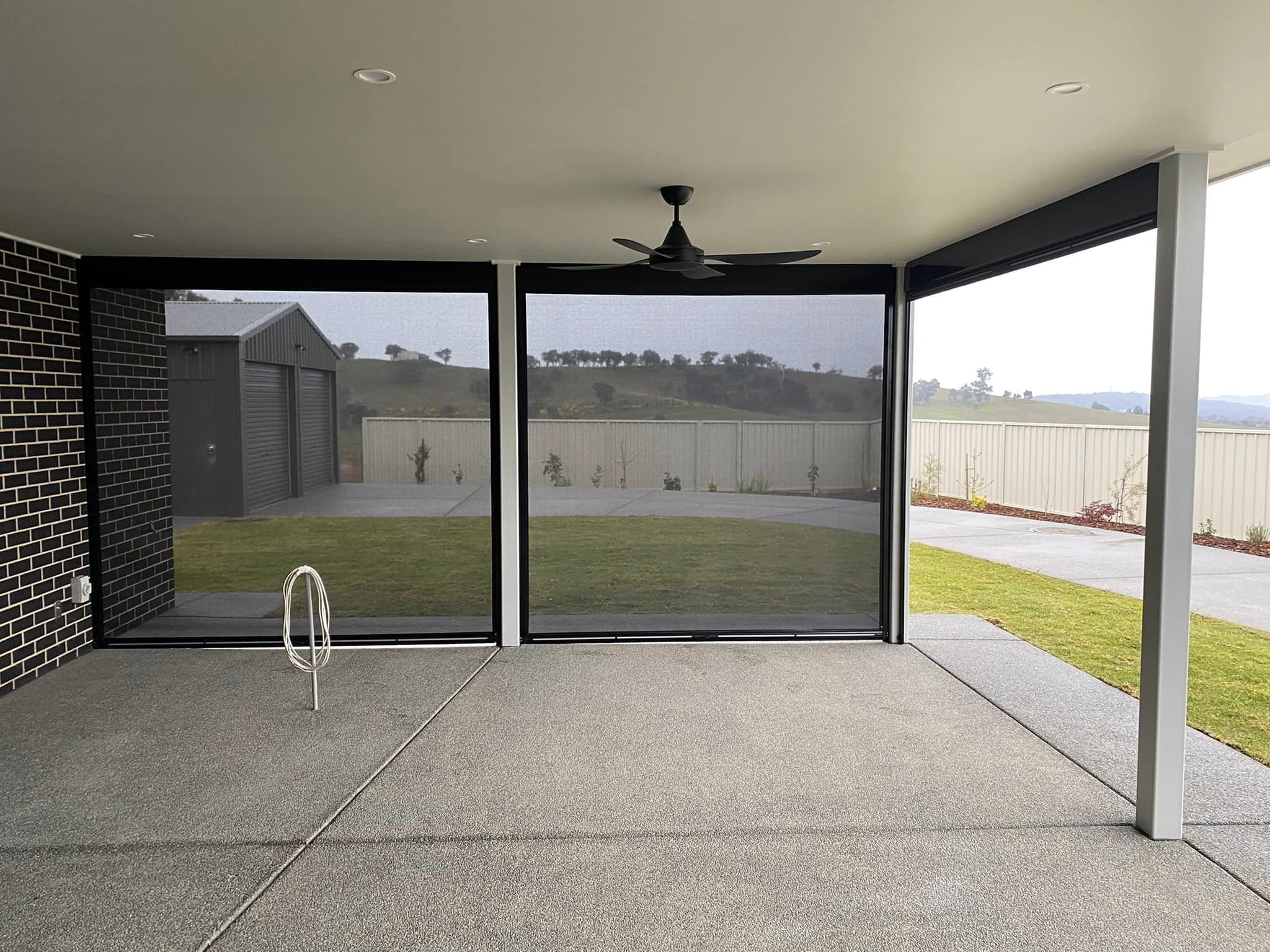Stylish Ways To Keep The Mozzies Out This Season
Its that time of year again, mosquito season. And with all the water laying around the seem to be more prevalent than ever! Julia Fairley from Houzz’s Editorial Team, provides you some stylish options to keep those pesky mozzies out, below.
Nothing compares to entertaining outside on a balmy evening, or enjoying a good night’s sleep with the windows open… until mosquitos arrive. Mozzies, flies and other insects relish warm weather as much as we do, but thanks to these stylish screening solutions you can relax outdoors and let the scent of summer waft into your home, without unwelcome winged guests crashing your party.
Vertical Retractable Insect Screens
The humble flyscreen has come of age with new retractable models sweeping the market. These sleek and subtle designs are operated by hand or remote control, and can be retrofitted to most doors, windows, patios, balconies and terraces.
Retractable insect screens work in a similar way to roller blinds and usually feature a spring-loaded system that neatly rolls the mesh back into its frame when not in use. Retractable screens are often the best option if you need mosquito netting for apartment balconies or patio enclosures. These designs can withstand wet weather and you can often choose from standard strength mesh or heavy-duty aluminium.
Horizontal Retractable Insect Screens
Tracks can also be fitted horizontally, which lets screens slide across wider openings then retract inconspicuously to one or both sides when not in use.
Freedom Retractable Screens of Australia are the industry leaders of retrofit retractable fly screens.
Most retractable flyscreens can span openings up to nine metres in length.
Fixed Flyscreens
Are usually fitted to the sidelights whilst the larger sections of window are not. A mix of screened and unscreened openings ventilates the home and provides plenty of natural light, while stopping mosquitoes in their tracks.
Hinged Screen Windows
Some of the most traditional mesh screens are the hinged varieties that most of us have had at some stage in our lives. These can be fitted to windows as well as doors.
Most hardware stores sell and cut flyscreen mesh from about $10 per metre, which you can use to create a screened porch. But beware this common DIY trap – although it can be straightforward to replace fly screens, constructing them from scratch is best left to the professionals.
Hinged Screen Doors
Flyscreen doors often do double duty as security screens too. Metal screen doors can be custom designed to suit your homes exterior. The security-grade mesh lets air and light in, but keeps more than just insects out.
Security screens can be fitted to windows as well as doors.
Pivoting Screen Doors
Are you keen to repurpose an old door with some flyscreen? Pay a thought to the mechanism you use to open and close it as well as the style of door.
Pivoting screens doors give a distinctive design that can blend seamlessly with your existing windows.
Sliding Screen Doors
Screen doors come in all shapes and sizes to suit every site and style, so don’t let convention dictate your design. Old sliding barn doors can be easily repurposed with wire mesh to create a stylish screening solution.
Fixed Screens For Balconies & Patios
Need a permanent mosquito screen for your patio enclosure or apartment balcony? A fixed flyscreen could be your answer. Large-scale insect screens are not only at home in traditional houses. Their barely-there nature means they suit almost any dwelling, even cutting-edge contemporary designs such as this fabulous screened-in courtyard.
Japanese Shoji Screens
Are you keen to embrace a screen that stands out, rather than blends in? Traditional Japanese shoji screens, with their beautiful and breathable washi or shoji paper panels, offer an option that sits between pervious flyscreens and impenetrable walls or glass doors.
Today, many shoji screens use fibreglass, frosted glass or acrylic panels, but traditionalists can still opt for true washi paper inserts. This translucent, porous material welcomes diffused light and balmy summer air indoors, but screens against mosquitos and bugs. Unlike fibreglass, glass or acrylic, washi paper inserts don’t withstand wet weather well, so shoji screens are ideal for undercover use.
Laser-Cut Screens
Laser-cut screens protect a home’s inhabitants from glaring sun and prying eyes, as in this London bathroom. They can also offer protection from marauding mosquitos when the smallest of perforations are used to puncture the screen.
Because it’s rare for the apertures to be as fine as those on flyscreens, laser-cut designs are not quite as effective at keeping insects out as good old-fashioned mosquito mesh. However, they pack a stylish punch and still prevent most bugs from flying inside.
Exterior Mesh Curtains
Mesh curtains (sometimes referred to as wire or metal curtains) turn the intensity up a notch from the mesh used in flyscreens. These offer a contemporary and more sculptural look than your humble insect screens. Mesh curtains are also usually thicker and have a looser weave, resulting in slightly larger apertures, so mesh curtains are not entirely foolproof in stopping insects in their tracks. Nevertheless, they offer a fashionable and reasonable deterrent.
For best results, hang your mesh curtains so they just scrape the ground. Depending on their weight you may not need a track on the floor. Aim to choose mesh curtains with apertures no larger than three millimetres in diameter to form a bug-proof barrier.
Outdoor Fabric Curtains
The whimsy of these breezy beauties is reason enough to rig up some alfresco curtains, even if you don’t have an insect problem. Outdoor curtains come in as many colours, patterns, designs and dimensions as indoor curtains, though the most important consideration is to choose a fabric specifically designed for outdoor use. Many fabrics filter ultraviolet light, so have an added sun protection bonus.
Use weather-resistant hardware so your curtain fabric isn’t stained by rust.
Mosquito Nets
Is there anything more romantic than gauzy mosquito nets draped around beds, billowing gently? I think not. These whimsical designs are like humans’ consolation for mosquitos’ existence.
Mozzie nets don’t offer full protection from bugs, so the best approach is to combine them with other options to deter insects from flying into your home in the first place. If, however, your existing flyscreens are less than perfect, hanging a mozzie net from your bed is usually the easiest and cheapest way to guarantee an uninterrupted night’s sleep this summer.
Mosquito-Repellent Plants
Many plants deter bugs, though only within their immediate micro-climate: plant them in one corner of your garden and you’ll still find mosquitos in another. If you have window boxes or planters near your front or back door, fill them with mosquito-repellant plants or flowers such as marigolds and geraniums, or herbs including lemongrass, lemon balm, citronella, lavender and rosemary, which are also great additions in the kitchen.
Here at Hurst Homes we offer complete customised homes that can be as individual as the owner. We guide your through the entire process including your selections to ensure you create your dream home. Each client personally meets with our joiners to design and create functional spaces, with colours tailored to their individual style. Just another reason why we are considered Wagga’s best builder. With over 30 years in the industry as a Wagga Builder you can trust Hurst Homes with your dream home. For information on our upcoming custom Wagga house & land packages, contact us today on 0438 692 962 or fill out the contact us page on our website.
For more tips and tricks from the Houzz experts visit Houzz.com.au

